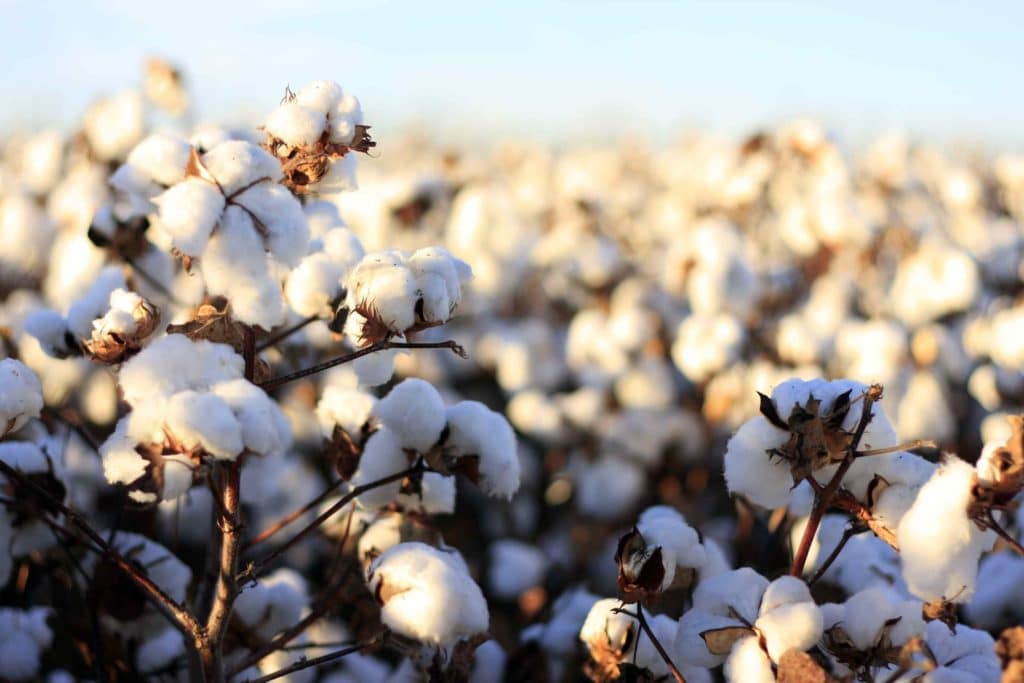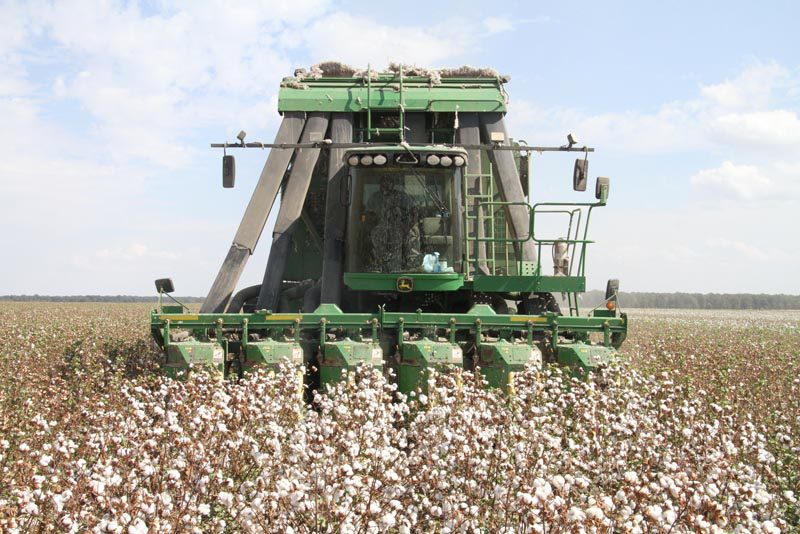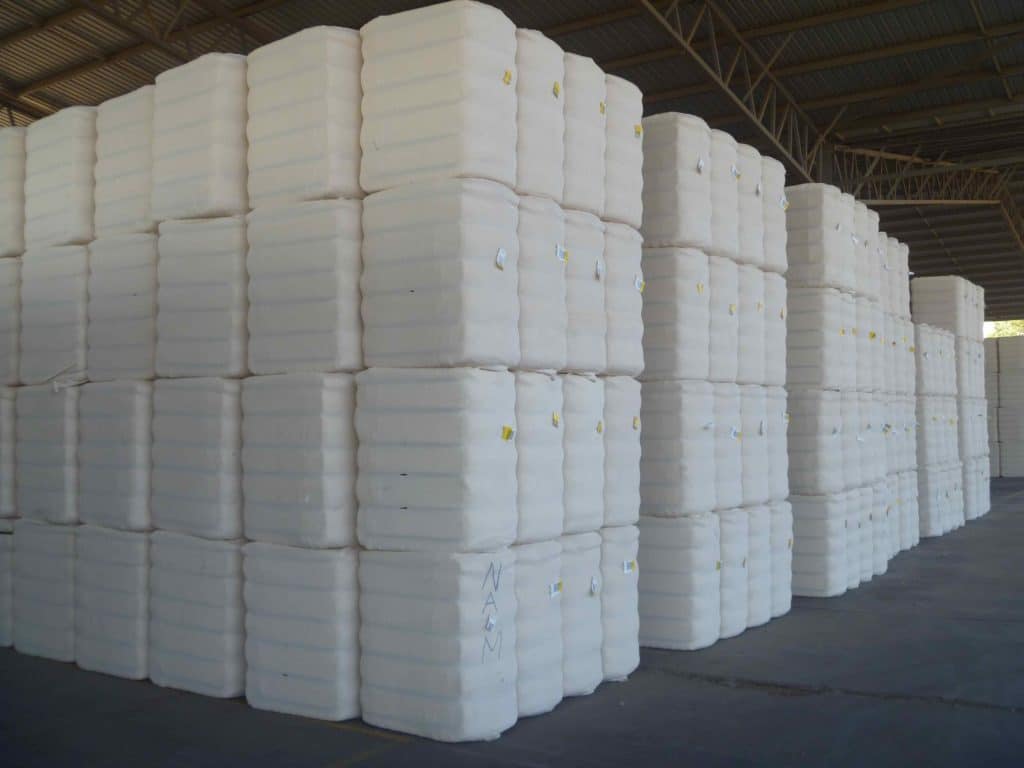Cotton is a natural fibre from the fruit of the cotton plant.
When spun, it yields a smooth and durable yarn that is easy to dye and weave. The longer the fibres, the higher the quality.
This Encyclopedia entry is a must-know term. Learn more in our Denim vocabulary.
Cotton explained
Cotton is the most important raw material in denim. Most of us know cotton from the soft pads and balls we use to stop bleedings and put on make-up.
It’s a natural fibre that comes from the cotton plant; an ancient crop has been cultivated for thousands of years. Cotton used to be a wild crop, but it evolved through breeding and genetic assistance to become easier to process and to provide better yield.

The cotton plant’s fruit, known as the cotton boll, yields a fluffy white, raw fibre called the ‘lint.’ That’s what’s used to make denim. Each boll is the size of a fig and contains around 500,000 fibres.
Cotton is one of the world’s most important crops in terms of usability, economic value and environmental impact of its production. In the denim industry, cotton is without question the most important raw material.
Back in the day, denim was almost exclusively made from 100% cotton. Today, consumers demand denim that stretches, which means the fabric will have some kind of polyester-based elastomer in it.
But even then, as much as 98-99% of the raw material is cotton.
How cotton is made
The cotton plant needs a lot of sunshine to grow. It takes an average of 140 days from the seeds are planted to the dried-up locks of cotton are ready for picking. The best yield comes from latitudes between 45° north and 30° south. To put that into perspective; that’s south of Venice in Italy and north of basically all of Africa.
Each plant produces around 300 to 350 grammes per season, from up to 100 bolls per plant. That means you need two plants to have enough cotton to make the denim needed for an average pair of five-pocket jeans.

Once harvested, the raw cotton goes through the ginning process at the cultivation site. This process separates the fibres from the seeds. The cotton is first vacuumed into tubes that carry it to a dryer to reduce moisture. Next, the cotton is cleaned to remove any foreign matter.
After ginning, the raw fibres are compressed into bales, each weighing around 250 kilos, which means enough to make denim for around 350 pairs of jeans.
These days, cotton is grown on all continents, with the exception of Antarctica, obviously. China, the United States, India and Pakistan are the world’s biggest cotton-growing nations. But Brazil, Turkey and Australia are also churning out their fair share, which is growing. When you add them all up, these countries supply the majority of the cotton that ends up in our denim.

Physical properties of cotton
Cotton is defined and categorised based on a set of physical properties, including staple length, fineness and maturity, strength and colour.
Staple length
Staple length refers to the length of the fibre, and it’s the most important physical property of cotton. There are several types of cotton with different staple lengths.
For jeans production, Upland cotton from the short staple family is most commonly used, with a staple length of one inch is sufficient.
Generally, short-staple cotton is cheaper and of lower quality. But since denim is usually made from yarn with a coarse yarn count—that’s the thickness of the yarn.
However, extra-long-staple (ELS) cottons such as Egyptian Giza, Indian Suvin, and Chinese Xinjiang can be used to make denim.
Fineness and maturity
The fineness and maturity of a cotton fibre are important too. The finer and more mature a fibre is the better the quality of it. These properties are measured in micronaire, which is the air permeability of compressed cotton. Using cotton with a low micronaire count leads to neppy yarn and more waste, as it breaks more easily.
Strength
There’s also the strength of the fibre, which is measured as tensile strength. This tells you the maximum load that fibres will hold before they break. Obviously, this influences the strength of the final fabric.
Colour
Finally, there’s the colour of the fibre, which distinguishes one batch of cotton from another. The colour is most important if the cotton ends up undyed in the fabric.

Benefits of cotton in denim
So, why is denim made of cotton? What are the benefits?
Apart from the fact that cotton’s been around for hundreds of years, it continues to be popular because it’s comfortable, breathable, durable, and because it looks great when you weave it into fabrics.
In terms of what makes one kind of cotton better than another, you need to look into the properties of the fibre. The longer the staple, the finer and more mature, and the stronger a fibre is, the higher the quality.
The quality of cotton also depends on where it’s grown, how it is harvested and the seasonal conditions during cultivation.
That being said, there are a few misunderstandings about the influence on the quality of where cotton is grown. A good example is ELS cotton from Zimbabwe, which is not by default higher quality than similar types of cotton grown in places like the US.
The difference is how it is picked and processed. In most developed countries, cotton is picked with large mechanical harvesters. In some developing nations, like Zimbabwe, cotton is still picked by hand.

